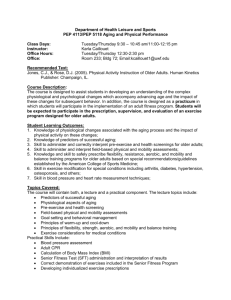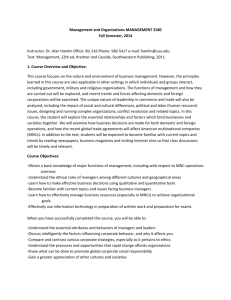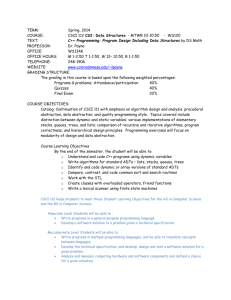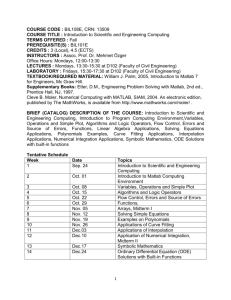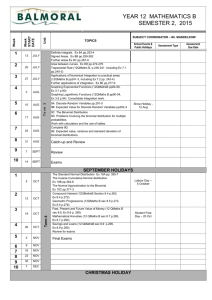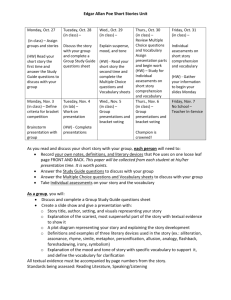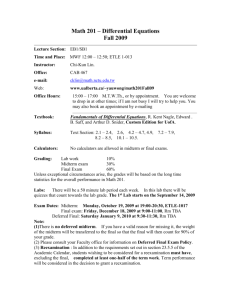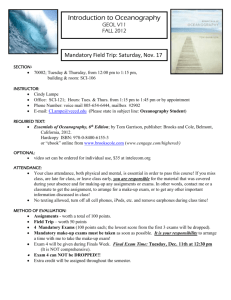GEO 1200/L - University of West Florida
advertisement
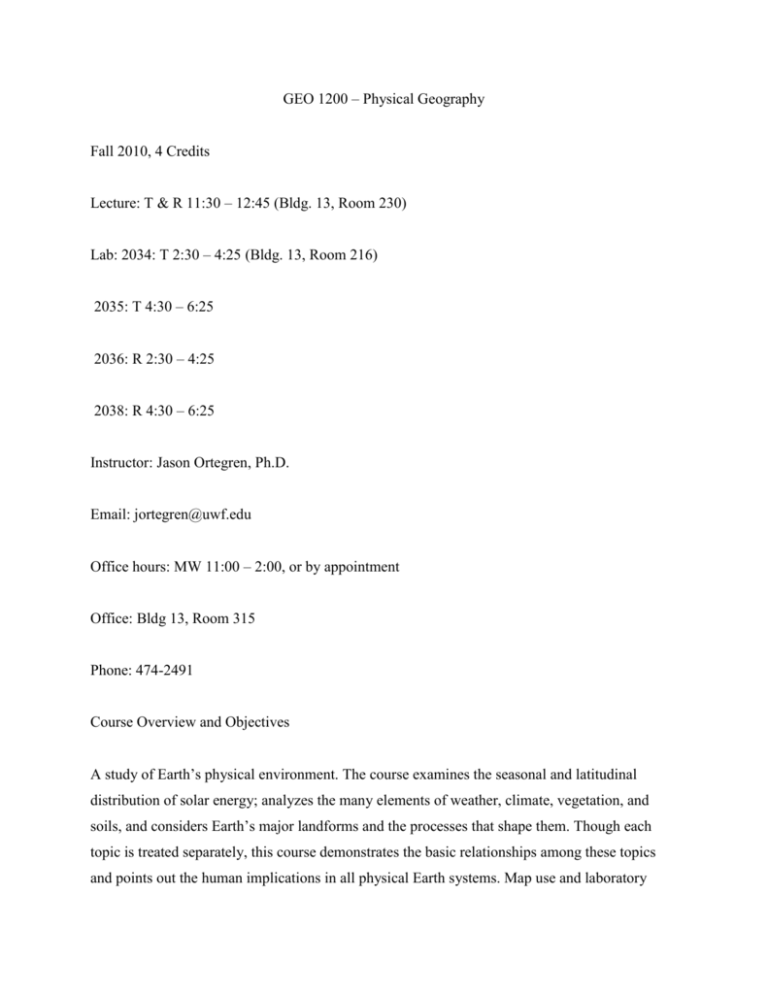
GEO 1200 – Physical Geography Fall 2010, 4 Credits Lecture: T & R 11:30 – 12:45 (Bldg. 13, Room 230) Lab: 2034: T 2:30 – 4:25 (Bldg. 13, Room 216) 2035: T 4:30 – 6:25 2036: R 2:30 – 4:25 2038: R 4:30 – 6:25 Instructor: Jason Ortegren, Ph.D. Email: jortegren@uwf.edu Office hours: MW 11:00 – 2:00, or by appointment Office: Bldg 13, Room 315 Phone: 474-2491 Course Overview and Objectives A study of Earth’s physical environment. The course examines the seasonal and latitudinal distribution of solar energy; analyzes the many elements of weather, climate, vegetation, and soils, and considers Earth’s major landforms and the processes that shape them. Though each topic is treated separately, this course demonstrates the basic relationships among these topics and points out the human implications in all physical Earth systems. Map use and laboratory work are an integral part of this course. By the end of this course, students should be able to: - Explain the basics of how the atmosphere, hydrosphere, lithosphere, and biosphere interact in Earth’s systems - Interpret various types of data, imagery, and maps that relate to Earth processes - Describe how various geomorphic agents shape Earth’s surface - Analyze the introductory principles of Earth-Sun relationships - Interpret the interrelationships between Earth’s energy balance and belts of air pressure and wind, as well as their influences on weather, climate, and the location of biomes. Text & Materials Geosystems. Christopherson, 6th edition (Required) ISBN: 0-13-153117-4 Physical Geography Lab Manual Supplement. (Required) -- Available at the University Bookstore. Online Materials: -- Companion website to Geosystems, 6e http://www.prenhall.com/christoperson/ Additional Materials for Lab: -- Calculator to be brought to lab Grading Exams (3) 60% Lab Exercises (9) 25% Assignments (4) 15% Grades will be assigned using the following scale (percent score): A 93.0 – 100 C+ 77.0 – 79.9 A- 90.0 – 92.9 C 73.0 – 76.9 B+ 87.0 – 89.9 C- 70.0 – 72.9 B 83.0 – 86.9 D+ 67.0 – 69.9 B- 80.0 – 82.9 D 63.0 – 66.9 D- 60.0 – 62.9 F < 60 I will randomly give four quizzes during the semester. The quizzes will be completed as a class, and will serve as review sessions. These four instances will be my attendance check. If you are present for all four attendance quizzes, you will receive a semester grade boost to the next highest grade modifier (sign), e.g., a grade of B- would become a B, or a C+ would become a B-. Note that a grade of F has no sign, and thus cannot receive a grade boost. Exams: Three exams, equally weighted, will be given at roughly equal intervals during the semester. The 3rd of these exams will be on the last day of class (Wed., April 21), and will cover the material since the 2nd exam. A comprehensive final exam covering material from the entire course will be given during the scheduled final exam time slot (Thur., April 29; 11:30 am – 2:00 pm). The comprehensive final is optional for students who have not missed any prior exams. However, if you miss an exam, the comprehensive final will be required and will serve as the make-up for the missed exam. NO OTHER MAKE-UP EXAMS WILL BE GIVEN FOR ANY REASON*. If you have completed all exams and choose to take the final, I will use your three highest exam scores (i.e., drop your lowest) when I compute your semester grade. The exams may include material from both the lecture and lab portions of the course. Laptops may not be used during exams. You must have prior permission to use translation devices during the exams. In the past, students who didn’t attend class regularly and didn’t study considered my tests to be difficult. Students who were diligent in terms of both attendance and regular study found my exams somewhat simple. Lab Exercises: Practical lab exercises provide a way to gain familiarity with applying concepts discussed in lecture, and facilitate hands-on experience with techniques and materials. Labs are conducted separately from lecture, but grades are combined at the end of the semester. Lab exercises are due at the end of your assigned laboratory session. Lab assignments must be completed in the lab room. If you do not attend lab, your lab work willnot be graded. If you cannot attend your regularly scheduled lab session for any reason, you must attend the other lab session associated with this lecture during the same week, or the teaching assistants’ office hours during the same week. If you do not attend the T.A.s’ office hours or the other lab session during the week in which you missed your own lab session, your lab exercise will not be accepted. You are welcome and encouraged to email, call or drop in during office hours with questions or concerns about any assignment, lecture topic, etc. Emails will typically be answered within 24 hours (weekdays). Miscellaneous: -- Laptops, cell phones and all other digital gadgetry must be turned off during class -- Please refrain from behaviors that distract those around you. This means talking. If you need to have a discussion with a classmate, DO IT OUTSIDE THE ROOM. Disabilities: Any student with a documented disability (e.g., physical, learning, psychiatric, vision, hearing, etc.) who needs reasonable accommodations must contact the Disabled Student Resource Center (474–2387). They will notify me so that we can make necessary arrangements. Code of Conduct: I begin with the assumption that UWF students are mature, responsible individuals. I have no reason to suspect that cheating or other misconduct will be any problem in my classes. However, as a student at UWF, you are responsible for understanding the UWF policies on student rights and responsibilities regarding academic misconduct (i.e., cheating), as well as the general code of conduct, which can be viewed in full at the following URLs: http://uwf.edu/academic/policies/misconduct/Academic_Misconduct_Policy_2007edition.pdf http://uwf.edu/osrr/documents/BOTApprovedStudentCodeofConduct-2007edition.pdf Remember that these policies outline your rights as a student, not just the policies to which you must adhere during your time at UWF. It is in your best interest to read and be familiar with these documents. Emergency Information: • WUWF-FM (88.1MHz) is the official information source for the university. Any pertinent information regarding closings, cancellations, and the re-opening of campus will be broadcast. • In the event that hurricane preparation procedures are initiated, the UWF Home Web Page and Argus will both provide current information regarding hurricane preparation procedures, the status of classes and the closing of the university. SCHEDULE OF LECTURE TOPICS AND TEXT READING (TENTATIVE) Week of: Topic Aug. 23 Introduction to Geography, Earth’s structure, the Rock Cycle; Ch. 1: pp. 1-7, pp. 13-27; Ch. 11: pp.323-338 Aug. 30 Theory of Plate Tectonics, Igneous activity and volcanic landforms; Ch. 11: pp. 339-355; Ch 12: pp. 384-397 Sep. 6 Mountain building, folding and faulting; Ch. 12: pp. 357-375 Sep. 13 Mountain building cont’d; Soil formation and classification; Ch. 18: pp. 577-582, pp. 584-604; Field Excursion 1 due Tuesday, Sep. 14 Sep. 20 Soils cont’d; Ch. 18: pp. 584-604 *************************** Thursday, September 23, EXAM 1******************** Sep. 27 Atmospheric composition, Heating the Earth, Reasons for the seasons; Ch. 3: pp. 61-74; Ch. 2: pp. 41-59 Oct. 4 Global temperature patterns, Measures of humidity, Adiabatic lapse rates; Ch. 4: pp. 89-101; Ch. 5, pp. 115-132 Oct. 11 Precipitation, stability versus instability, processes that lift air; Ch. 7: pp. 181-204; Case Study 1 due Tuesday, Oct. 12 Oct. 18 High and low pressure zones; mid-latitude cyclones, frontal weather patterns; Ch. 8: pp. 207-220; Oct. 25 Severe weather; Earth’s climates; climate change; Ch. 8: pp. 220-240; Field Excursion 2 due Thursday, Oct. 28 ************************** Thursday, October 28, EXAM 2************************ Nov. 1 Weathering, soil erosion, and mass wasting; Ch. 13 Nov. 8 Principles of river flow, stream valley formation; VET’S DAY, NO CLASSES THURSDAY; Ch. 14 Nov. 15 Arid landscapes and wind erosion; Glacial landscapes; Ch. 15; Ch. 17 Nov. 22 Coastal landscapes and beach erosion; T’GIVING, NO CLASSES THURSDAY Ch. 16: pp. 499-518; pp 523-526; Case Study 2 due Tuesday, Nov. 23 Nov. 29 Wrap-up **************************Thursday, December 2, EXAM 3 *********************** SCHEDULED FINAL (MAKE-UP) EXAM: Tuesday, December 7, 11:30 am – 2:00 pm Fall 2010 GEO 1200L: Physical Geography Lab Instructor: Jason Ortegren, Ph.D. Lecture: T & R 11:30 – 12:45 ____________________Tentative Lab Schedule_____________________ WEEK OF:____ TOPIC_____________________________ Aug. 30 (week 2) Lab #1: Latitude & Longitude Sep. 6 (3) Lab #2: Location Sep. 13 (4) Lab #3: Soils Sep. 20 (5) EXAM 1; NO LAB Sep. 27 (6) Lab #4: Contours & Topog. Oct. 4 (7) Lab #5: The Climate Puzzle Oct. 11 (8) Lab #6: Atmospheric Pressure Oct. 18 (9) Lab #7: Hurricanes Oct. 25 (10) EXAM 2; NO LAB Nov. 1 (11) Lab #8: Water Resources Nov. 8 (12) VETERAN’S DAY; NO LAB Nov. 15 (13) Lab #9: Deserts Nov. 22 (14) THANKSGIVING; NO LAB Nov. 29 (15) EXAM 3; NO LAB Field Excursion 1: SENSES & SPHERES DUE: SEPTEMBER 14 Total Points: 30 Length: 500 words Descriptions for Parts I and II may be in the form of organized lists, narrative paragraph, poem, etc, but you must be sure to specifically answer the questions asked. The assignment should be typed. PART I: Spend about 15 minutes outside. Describe where you are. Notice how each of your senses are involved in experiencing the four spheres of the earth’s system. Describe everything that you experience during this time. What do you hear? see? smell? touch? taste? from each of the four spheres? (15 pts.) Please choose a location in which you will be exposed to the natural system, i.e. sitting in a car in an empty parking lot is not a good option. PART II: Notice specifics. Landscape – what does the landscape look like? Is it flat? tilted? rolling? Does the landscape seem to be fairly natural or human constructed? How deep do you think the soil is where you are standing? What might have formed the bedrock beneath? Are there any identifiable land features that you can describe, e.g. river, lake, hill, valley, etc? Rock – find a rock. Using as much detail as possible describe your rock. What is the color? texture? shape? size? where did you find it? Where do you think this rock came from? Do you think it was formed at this location, or transported from elsewhere? Soil – pick up a handful of soil. Using as much detail as possible describe your soil. What is the color? texture? what types of things are mixed in with your soil? How deep is the soil here? Sky – describe the current sky conditions. Is it raining? Do you see clouds? Describe their shape, color and texture. In which direction do they seem to be moving? Can you see the sun? Where is the sun in the sky? What time is it now? What time was sunrise this morning? What phase of the moon are we in? What time was moonrise today? Air – take a deep breath. Are there any specific smells or tastes on the air? What is the temperature (your best guess)? Do you think the air is humid or dry? Vegetation – choose one specific plant at this location. What does it look like? Do you know what kind of plant it is? Are the edges of the leaves jagged or smooth? Describe the stem/trunk. How long do you think plants of this type have been growing in this location? 200 years? 1 million years? Why? In what location of the landscape is this plant located (near water, top of hill, north side of house, etc). Animals – are there any animals in your landscape? Dog? Insect? Do you know what kind of animal it is? How does it seem to be interacting with the other elements of the landscape? Case Study 1: NATIONAL PARKS DUE: Oct. 12 Total Points: 20 Length: 500-750 words Choose a National Park from http://www.nps.gov/. Under ‘Parks and Recreation’ you can search for parks. Please explore the variety of parks that are available. You may NOT research Grand Canyon National Park or Yellowstone (as I have read too many papers on these already). Cite all sources used. Make sure your writing is in your own words. Once you have chosen a park, plan a geographic vacation to the area. Your paper should be in the form of a descriptive itinerary. Explain how you will travel, what dates you will be away, where you will stay, the physical geographic importance of each location you will visit, and your rationale for making each of these decisions. It should also include an approximate budget. This paper should be fun and allow you to be as creative as you wish, as long as you show that you have put some thought into your decisions. Field Excursion 2 – YOU PICK A LOCATION DUE: Oct. 28 Total points: 30 Length: 500-1000 words Location suggestions: Gulf Islands National Seashore A great excuse to head to the beach. Try to find someone in your lab section who wants to carpool. You may want to do a short study of websites that describe some of the processes important to the Gulf of Mexico and the shoreline of northwest Florida, so that you will know what you are looking at when you get there. UWF Nature Trail Outside Bldg. 13, wander through a forested marshland. Possible wildlife viewing; beware reptiles, amphibians, and biting/stinging insects. Spring Break / Nature Center If you have travel plans for Spring Break, a road trip weekend, or perhaps have a Nature Center or Preserve in your hometown, these are also allowable locations for you excursion. You may want to do a short study of websites that describe some of the landscape processes important to your destination so that you will know what you are looking at when you arrive. ** You are not limited to these suggested locations. Any reasonable outdoor location (that you have not used for a Case Study or for Field Excursion 1) will suffice. If you are not sure about a location that you are considering, feel free to check with me in advance. Spend approximately 1-2 hours at your chosen location. The resulting paper should be in the form of a free-form journal describing your experiences. Although the journal should be typed for grading, I recommend that you actually journal while you are on location and make notes of all the information that you want to discuss. Some suggestions for your discussion: • Date, time, location o Situate us spatially and temporally at a particular location. • Observable characteristics of the environment o This section can be similar to those types of things discussed in Case Study 1. Focus on the aspects of atmospheric processes, soil, geology, vegetation, landforms, etc that you can actually observe. o Are there specific shapes/ kinds/ types of wind, water, landscapes, vegetation that seem characteristic of this environment? Describe. o Are there several types of environments to compare and contrast? o Specifically list the species that you recognize in the environment. Describe at least 1 species that you do not recognize (draw pictures or write detailed descriptions) and describe where you observed it. • Compare and contrast o Compare and contrast the various microenvironments at this location. Are there observable differences in the characteristics you described above from one location to another. o Describe similarities and differences between this location and the location you examined during Case Study 1 or in the other excursion exercises that you have completed. • ***** Unanswerable questions ***** o What questions arise in your mind during this observation. They can be silly or immense. What puzzles you? What piques your curiosity? Case Study 2: SEVERE WEATHER DUE: Nov. 23 Total Points: 20 Length: 300-500 words PART I Tell me about an experience that you have had with severe weather. (10 pts) PART II As a part of the paper, describe the physical geographic terms and processes behind such an event. (10 pts) Feel free to use your book, lecture notes, and outside sources if they will help you explain the experience. Cite any outside sources used. Any TRUE severe weather story with a personal tie is acceptable, as long as you also explain the geographic situation. Grading scheme (for each of the four assignments): Thoroughness of your observations 65% Clarity and conciseness in writing 25% Grammer, punctuation, proofreading 10%
